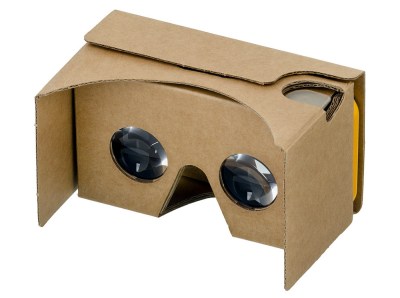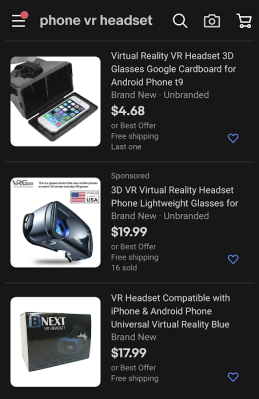Google Calls It Quits With VR, But Cardboard Lives On

Google giving up on one of their projects and leaving its established userbase twisting in the wind hardly counts as news anymore. In fact, it’s become something of a meme. The search giant is notorious for tossing out ideas just to see what sticks, and while that’s occasionally earned them some huge successes, it’s also lead to plenty of heartache for anyone unlucky enough to still be using one of the stragglers when the axe falls.
So when the search giant acknowledged in early March that they would no longer be selling their Cardboard virtual reality viewer, it wasn’t exactly a shock. The exceptionally low-cost VR googles, literally made from folded cardboard, were a massive hit when they were unveiled back in 2014. But despite Google’s best efforts to introduce premium Cardboard-compatible hardware with their Daydream View headset two years later, it failed to evolve into a profitable business.

Of course if you knew where to look, the writing had been on the wall for some time. While the Daydream hardware got a second revision in 2017, and Google even introduced a certification program to ensure phones would work properly with the $100 USD headset, the device was discontinued in 2019. On the software side, Android 7 “Nougat” got baked-in VR support in 2016, but it was quietly removed by the time Android 11 was released in the fall of 2020.
With Cardboard no longer available for purchase, Google has simply made official what was already abundantly clear: they are no longer interested in phone-based virtual reality. Under normal circumstances, anyone still using the service would be forced to give it up. Just ask those who were still active on Google+ or Allo before the plug was pulled.
But this time, things are a little different. Between Google’s decision to spin it off into an open source project and the legions of third party viewers on the market, Cardboard isn’t going down without a fight. The path ahead might be different from what Google originally envisioned, but the story certainly isn’t over.
The Case For Cheap VR
Clearly Google was cooling on the idea of phone-based VR for some time, but their exit from the market was further accelerated by the arrival of new stand-alone VR headsets from the likes of Oculus that far outperformed Cardboard. But not all consumers saw this as a step forward. While the new VR headsets were undoubtedly impressive, they were also expensive and introduced new software ecosystems that many users were reluctant to buy into. There’s still a market for cheap headsets that allow smartphones to be used for rudimentary VR, but it simply isn’t lucrative enough to entice a company like Google.
 Of course not all companies have such high standards. Despite the considerable limitations of smartphone VR, there’s no shortage of Cardboard-like headsets available for consumers to chose from. They range from cheap toy store fodder to more advanced units that try to deliver the high-end experiences Google offered with their own Daydream Viewers.
Of course not all companies have such high standards. Despite the considerable limitations of smartphone VR, there’s no shortage of Cardboard-like headsets available for consumers to chose from. They range from cheap toy store fodder to more advanced units that try to deliver the high-end experiences Google offered with their own Daydream Viewers.
A quick search on Amazon or eBay returns a seemingly unending string of VR headsets for every possible budget or application; all relying on nothing more than the smartphone you already bought and paid for. It’s easy to look at these headsets, many coming from fly-by-night companies, and see them as cheap clones looking to capitalize on Google’s idea. But the reality is, the Cardboard viewer specification was always intended to be open source.
Even if most manufacturers decided not to take the literal cardboard route that Google pioneered, the general layout of the viewer and the best practices outlined in the accompanying documentation were an invaluable base to work from. It didn’t take these companies long to adapt the basic Cardboard premise into a rigid plastic frame, and from there, start layering on new features and capabilities to set themselves apart from the competition.
Can a $5 USD plastic box with shoddy lenses compete on a technological level with stand-alone VR headsets, to say nothing of the models that use a gaming PC to provide the visuals? Of course not. But that’s hardly the point. Outfitted with a second-hand phone, these low-cost devices can deliver immersive 360° visuals at a fraction of the price. That means bringing VR to people and places that otherwise never would have had access to the technology.
Software for Seeing Double
While the state-of-the-art might not evolve much beyond where it is currently, Cardboard derived VR headsets aren’t going away anytime soon. Of course, the hardware is only one half of the equation. With the VR functionality already stripped from the latest release of Android, what will users actually be able to use these devices for?
 The good news is that while Android might have lost its native VR capabilities, they were never terribly important in the first place. Achieving a basic stereoscopic effect is as easy as displaying two viewpoints on the screen at once and letting the optical properties of the headset handle the rest. It’s a simple enough trick that can even be pulled off with an
The good news is that while Android might have lost its native VR capabilities, they were never terribly important in the first place. Achieving a basic stereoscopic effect is as easy as displaying two viewpoints on the screen at once and letting the optical properties of the headset handle the rest. It’s a simple enough trick that can even be pulled off with an ffmpeg filter, and certainly doesn’t require any operating system level optimizations. Especially given the ever-increasing computational power of the average smartphone.
But as it so happens, Google has also released the Cardboard SDK as an open source project. This allows developers to create cross-platform VR experiences for Android and iOS, and provides functions for motion tracking and stereoscopic rendering. The official roadmap shows there are plans to continue development of the SDK, though it’s worth noting no commits have been made since December of 2020. That said there are a number of active forks of the project, so even if Google is no longer actively contributing, the community seems willing to keep pushing the SDK ahead for the time being.
Pioneering Responsibly
Google has rightly caught a lot of flack in the past for abandoning products without giving them a chance to succeed, or worse, killing a product off without having an exit plan in place, but it’s hard to find fault in how they’ve decided to wind down Cardboard. We could debate why they were unable to monetize the concept of phone-based VR, especially with public interest being so high, but it’s a moot point. The important thing is that the community was given unfettered access to the Cardboard hardware and software once Google decided they couldn’t make money off of the idea.
Ultimately, Google’s handling of Cardboard is a fantastic example of innovation done right. Tech companies will always engage in this sort of speculative development in pursuit of the next best thing, and invariably, many of those ideas will fail to become profitable. Instead of locking up all that research and development where no one can access it, we should encourage companies that take the noble route of open sourcing their harebrained schemes. Just because they couldn’t figure out how to make it profitable doesn’t mean we can’t figure out how to make it work.
from Blog – Hackaday https://ift.tt/31tM2g0
Comments
Post a Comment